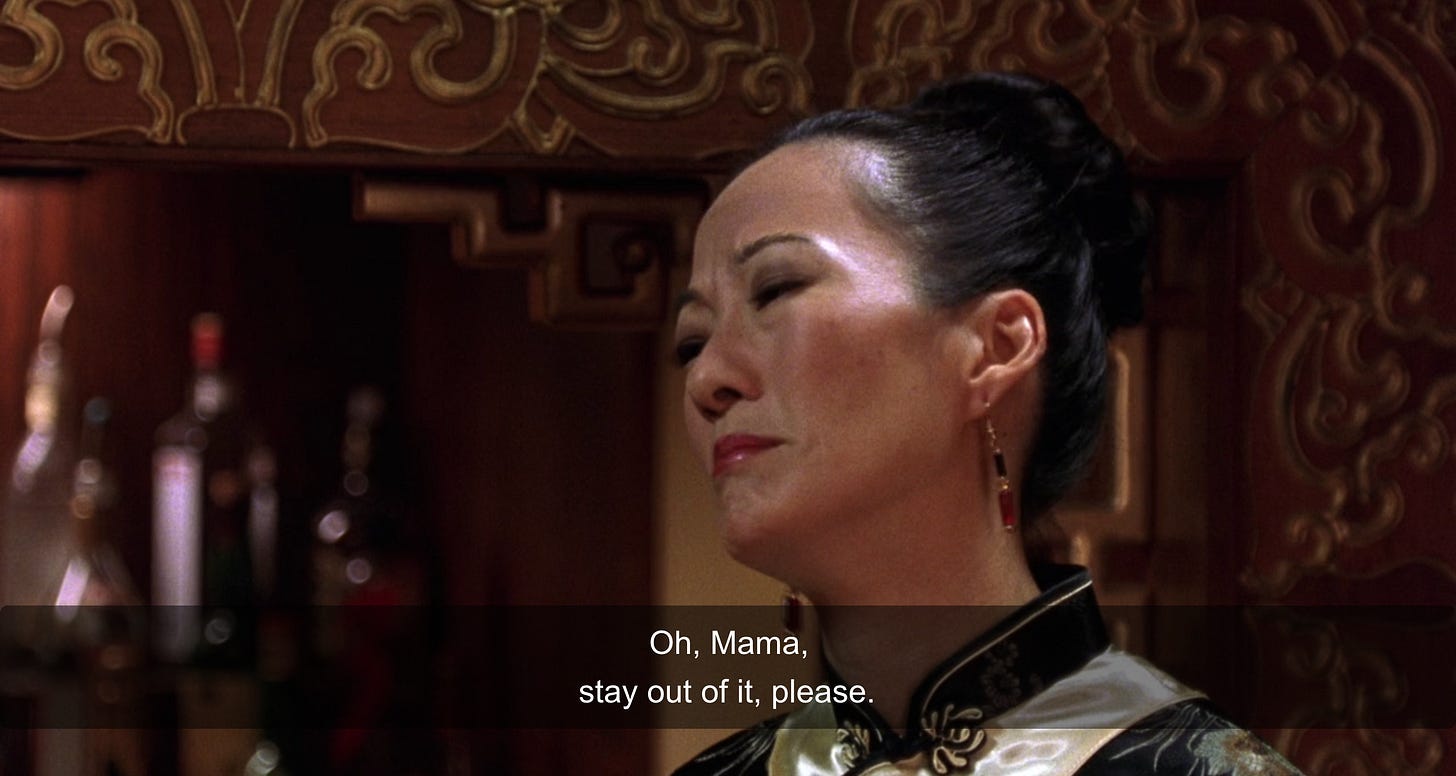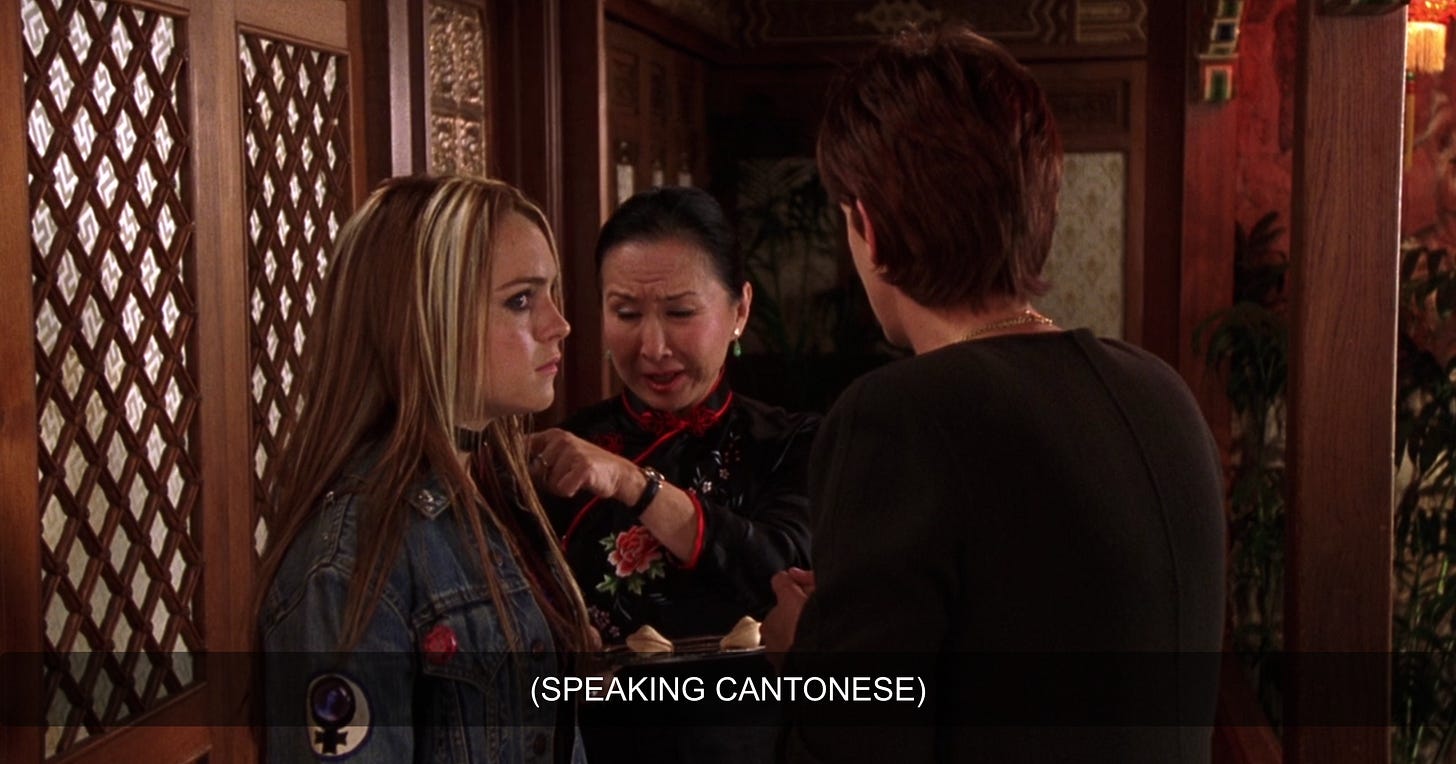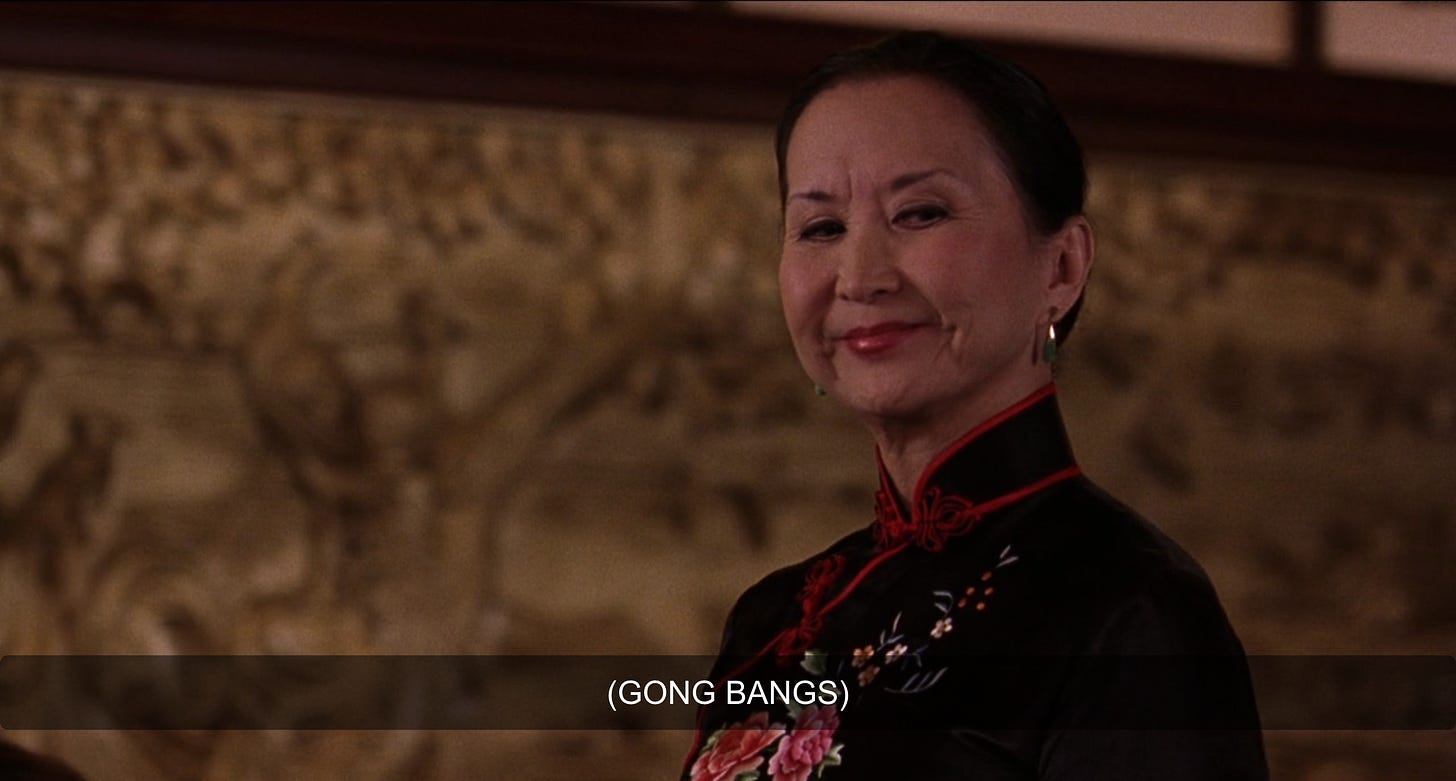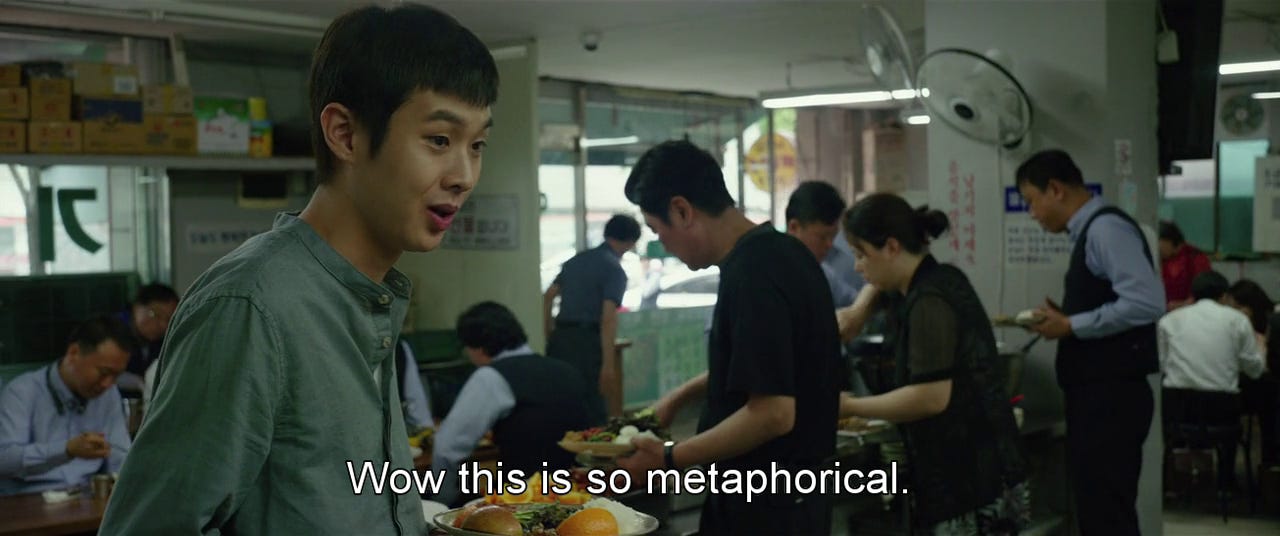to the beat of the gong
Freaky Friday is one of the richest texts in the Lindsay Lohan Cinematic Universe. In this essay I will
Sometimes I think that watching Freaky Friday so many times as a kid created a self-fulfilling prophecy for my adolescence. Teenage girlhood, as modeled by Lindsay Lohan, meant fighting with your mom. I dutifully followed suit, even slamming my door shut once in a fit of petulance. I couldn’t tell you what I was mad about and I rarely risked that kind of rebellious outburst again, but as the smack of the slam rang in my ears and my heart raced with equal parts exhilaration and guilt, I remember feeling like I’d finally become the type of girl that I watched movies about.
Of course, my mom and I would’ve clashed even if I’d never watched Freaky Friday. There’s too much we disagree about for it to have gone any other way:
her proclivity for modesty and temperance in all things vs. my personal philosophy that nipples are an accessory;
her devout adherence to organized religion vs. the specific brand of animosity I reserve for authority figures who believe they’re endowed with power from on high;
her view of pop culture as a polluting, corrupting force vs. my will to live being dependent on having a new TV show, movie or album to look forward to;
and her vision of what my future will hold (a husband and kids and an impeccable church attendance record) vs. my inability to picture choosing any of that for myself.
In almost every way that counts, our world-views are incompatible. It’s just that for most of my life, Freaky Friday was the only movie I’d seen that so explicitly concerned itself with mothers and daughters and the way we wound and misunderstand each other. If any movie was going to put my own complicated relationship with my mom into perspective, I figured it would be this one.
For the uninitiated, Freaky Friday is a Disney body-swap movie about MILFs, Lindsay Lohan doing Avril Lavigne cosplay, and the chances of your therapist not liking you being higher than you think. Released in 2003 (the same year Fountains of Wayne dropped “Stacy’s Mom,” another MILF-focused pop culture moment) and directed by Mark Waters (Mean Girls and Vampire Academy), it stars Jamie Lee Curtis and Lindsay Lohan as a widowed therapist mother and an aspiring musician daughter, respectively, who find themselves trapped in each other’s bodies for a day. Both mother and daughter have a big event scheduled for that very evening: a wedding rehearsal for Tess (mother) and an audition for a House of Blues gig for Anna (daughter). With time running out, Anna and Tess have to figure out how to switch back or else risk being stuck in each other’s bodies forever. Highlights include: Anna’s band Pink Slip performing genuinely catchy pop-rock bangers, Chad Michael Murray as the motorcycle-riding love interest with hair long enough to tuck behind his ears, and Julie Gonzalo (Shelby in A Cinderella Story) making yet another appearance as an evil, popular blonde.
The body-swap conceit is the ultimate challenge for two characters determined not to see things from each other’s perspective. What is it about the dynamic between mothers and daughters that makes this type of mutual empathy so hard to grasp that it can only be accessed through a supernatural event? Since Mary Rodgers wrote the original Freaky Friday novel in 1972, this story of a mother and daughter being forced to grapple with the material reality of each other’s lives has been adapted numerous times (including a 1976 film featuring Jodie Foster as the misunderstood daughter). We’ve returned to it over and over again because it prescribes a temptingly tidy treatment for a condition that’s always messier in real life. If only the ills of being and/or having a mother could be resolved by spending 24 hours in each other’s bodies.
Since the pandemic began, the person I see every day – the only person I see for most of the week – is my mom. We haven’t spent so much time solely in each other’s presence since I was in high school. I feel almost as stir-crazy as I did back then. Over the summer, my mom developed a habit of springing her religious testimony on me without any warning. Cornering me when I least expect it, she tells me about how angry and lost she was when I was growing up, how becoming a mother doesn’t mean you always do right by your children, and how finding peace in God all these years later has made her reevaluate our relationship. It always ends with her in evangelism-fueled tears, imploring me to relinquish control of my life to Jesus like she has. As though you can convert someone by sheer force of will. She says she was an inadequate mother and asks for my forgiveness; I say I don’t think she has anything to atone for, but that I forgive her for whatever wrongs she believes she committed; unsatisfied, she repeats the routine all over again a few weeks later. Whatever absolution she seeks – I don’t think I can give it to her. The latest remix on her spiel is asking me to name specific instances where she hurt me or pissed me off, so she can apologize and my forgiveness can be more meaningful. Even if I wanted to – and my avoidant tendencies mean I definitely don’t – I would have trouble pinpointing discrete scenes of emotional significance because I spent my formative years learning how to swallow my feelings so nobody else would have to deal with them. All that’s left to remember is a near-constant state of simmering frustration and helplessness. How can I ask my mom to apologize for upholding values I find antithetical to my own? I can’t alter her convictions anymore than she can change mine. Not even a body-swap could fix us.
I rewatched Freaky Friday recently for the first time since my preteen years, anticipating all the tangled feelings about moms and daughters and unbridgeable chasms that it would give rise to. But what stood out most to me this time was the film’s use of a constructed Asian mysticism as the engine of its central plot device. In the original novel and pre-2003 adaptations, the mechanics of the body-swap remain a mystery – the fallout matters more than the set-up. The version I grew up watching, however, traces the magic back to a pair of fortune cookies and the Chinese woman who offers them to Anna and Tess. During a family dinner at the House of Chang restaurant, owner Pei-Pei and her mother overhear Anna and Tess fighting. Despite Pei-Pei’s warning to stay out of it, her mother – who remains nameless and is listed on IMDB simply as “Pei-Pei’s Mom” – decides to set Anna and Tess on the path toward swapping bodies by offering them a pair of magical fortune cookies.
What compels her to meddle in other people’s lives without their knowledge or consent? Has she ever gotten caught before? When did she discover her power and what are its limits, if any? Do we trust that she won’t wield it to harm others, intentionally or not? Can Pei-Pei also make people switch bodies but just chooses not to? The movie doesn’t bother answering these questions because Pei-Pei and her mom aren’t three-dimensional characters with inner lives or emotional arcs – they’re symbols of the Mystic East, deployed to resolve the emotional strife of the white protagonists and cast a vague shimmer of exoticism over the film.
The concept of “the East” as a separate realm perpetually stuck in the past is one of the oldest tricks in the Guide to Othering Asians book. Orientalism divides the world into “two unequal halves, Orient and Occident” (Said 12). In manufacturing what it is not (i.e. lesser, threatening, weak, infected, corrupt, or whatever pejorative concept best suits the needs of the moment), the Occident is also able to define what it is. The logic of Orientalism isn’t governed by “empirical reality,” but by “a battery of desires, repressions, investments, and projections” instead (Said 8). The Orient, in other words, bears no resemblance to actual Asian countries or their people. It emerges from the Occident’s imagination and walks onto movie and television sets and the pages of books and newspapers and eventually into our everyday lives. The fiction of the Orient is like a funhouse mirror that makes a mockery of my body and my self-image, and whatever monstrous visage forms in the reflection is used to justify the violence of U.S. imperialism.
Analyzing media depictions of Asians can illuminate specific ways that Orientalism articulates itself. Jane Naomi Iwamura has done this work by examining the Oriental Monk figure in American pop culture from 1950 to 1975. The Oriental Monk, which set the precedent for the role Pei-Pei’s Mom plays in Freaky Friday, is “the representative of an otherworldly (though perhaps not entirely alien) spirituality that draws from the ancient well-spring of ‘Eastern’ civilization and culture” (Iwamura 6). If any readers of Homebody are also New Girl viewers, then this description should sound mightily familiar (Nick’s silent Asian spiritual guide, Tran, anyone?), but that’s a hot take for another day. The Oriental Monk figure came to prominence after World War II, along with other caricatures of Asian people that were “friendlier, [and] more subservient” than the stereotypes that abounded during the first wave of Asian immigration to the U.S. in the late-nineteenth and early-twentieth centuries (Iwamura 9). Stereotypes like Yellow Peril, Dragon Ladies, evil Fu Manchu, and the inscrutable Oriental still persisted, of course. But in the latter half of the twentieth century, we got a little variety sprinkled into the discourse of our dehumanization: the model minority, the Lotus Blossom, the comic relief sidekick, the prostitute with a heart of gold, and, of course, the Oriental Monk, who embodies Westerners’ “romantic visions of a transhistorical, transcultural spiritual essence” inherent to the East (Iwamura 9). By relegating the East to the realm of mysticism and magic, the West marks it as pre-modern, inferior, and hopelessly out of its league compared to technologically advanced Western societies. But wait, purveyors of this stereotype might protest, it’s not like the Oriental Monk figure is demeaning to Asians – it implies that they have access to reserves of uncanny Oriental spirituality that nobody else can touch. Isn’t that actually empowering?
The answer, obviously, is still no. The details of the Oriental Monk’s abilities and knowledge are less important than the ends to which he applies them – namely, helping white people achieve spiritual enlightenment and acting as their “ideological caregiver” (Iwamura 20). By passing ancient Eastern wisdom onto the worthy Westerner, the Oriental Monk is framed as the savior of the West, rescuing it “from capitalist greed, brute force, totalitarian rule, and spiritless technology” (Iwamura 20). Christ Goto-Jones describes a key dynamic in the Occident’s relationship to the Orient: “[Western magicians] were torn between wanting to believe in a distant but still-living space of phantasmagoria and also wanting to assert the developmental superiority and universal consistency of (Western) modernity” (5). The Oriental Monk resolves this tension by using the Occident’s fantasy of Eastern spirituality in service of the West’s continued cultural dominance. There’s no harm in a little Oriental magic, as long as we’re clear on who it benefits.
She’s not an all-knowing monk, but Pei-Pei’s Mom nevertheless fulfills the same function as the Oriental Monk figure. For all that Anna and Tess complain about “Pei-Pei’s crazy mom” and her “strange Asian voodoo,” she’s ultimately proven right – thanks to her mystical powers, the white American nuclear family is saved. Single white motherhood and family animosity, solved in one fell swoop by a nosy Chinese mom holding out two fortune cookies.
Speaking of fortune cookies – it’s fitting that the instrument of the Chinese “voodoo” in Freaky Friday doesn’t even originate from China. Who exactly can take credit for inventing the fortune cookie is still hotly disputed to this day, but there’s no question that it has no place in the ancient Chinese culture from which Pei-Pei’s Mom apparently gets her spiritual energy. The “fortune” written inside Tess and Anna’s cookies only heightens the absurdity of framing a modern marketing strategy as an ancient artifact. The East’s mystical secrets, neatly packaged for Western consumption.
Some Asian characters aren’t written to be anything more than walking, talking fortune cookies – vessels containing ancient truths and proverbs and little else. Take Charlie Chan, the fictional police detective and protagonist of a popular mystery novel series in the 1920s and 1930s who solved crimes using “a certain type of wisdom that was remote and inaccessible to even the cleverest of Westerners – Oriental wisdom” (Iwamura 18). Based on real life Hawaiian police detective Chang Apana, Charlie Chan was white author Earl Derr Biggers’s attempt at a heroic alternative to villainous Asian caricatures like Fu Manchu. Hate to break it to you, Earl, but well-intentioned Othering is still Othering. And when white actors in yellowface portrayed Charlie Chan in over 40 films, the character’s supposed markers of Asianness reached insulting levels of parody. In the midst of solving crimes, Chan dropped bars like “if strength were all, tiger would not fear scorpion,” and “insignificant molehill sometimes more important than conspicuous mountain,” which sound like exactly the type of shit you’d get from a fortune cookie. Oriental wisdom, after all, must be “mysterious yet unthreatening, easy to digest, and always entertaining” (Iwamura 19).
Do you think the sentence below is something I found after googling “fortune cookie fortune generator” or a Charlie Chan quote?
“Confucius say, ‘Luck happy chain of foolish accidents.’”
If you guessed Charlie Chan quote, you’re right – the character said this in the 1936 film Charlie Chan at the Opera.
When Anna and Tess confront Pei-Pei about her mom making them switch bodies, she shrugs and dispenses some fortune cookie wisdom of her own: “When the fortune come true, then you go back, not before. You find the answer in each other.” As an intermediary between the Occident and Orient who comfortably negotiates both Eastern spirituality and Western capitalism, she’s uniquely positioned to confirm to Anna and Tess that some unknowable Oriental force really is pulling the strings of fate. It’s a nightmare, it’s a fantasy, it’s an adventure set to the beat of a gong. How many times have I furtively wished for someone or something else to take the reins so I don’t have to deal with the responsibility of making my own decisions, just for a little while? All this time, and the answer was right in front of me: be white and crack open a fortune cookie.
Works Cited
Goto-Jones, Chris. Conjuring Asia: Magic, Orientalism, and the Making of the Modern World. Cambridge University Press, 2016.
Iwamura, Jane Naomi. Virtual Orientalism: Asian Religions and American Popular Culture. Oxford University Press, 2011.
Said, Edward. Orientalism. Vintage Books, 1979.













